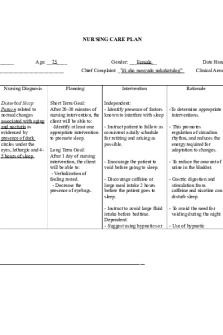117006719 Ineffective Breathing Pattern Pneumonia Nursing Care Plan PDF

| Title | 117006719 Ineffective Breathing Pattern Pneumonia Nursing Care Plan |
|---|---|
| Author | crown holder |
| Course | Nur Sit Practice: Childbearing |
| Institution | Florida Atlantic University |
| Pages | 2 |
| File Size | 129.1 KB |
| File Type | |
| Total Downloads | 37 |
| Total Views | 143 |
Summary
Download 117006719 Ineffective Breathing Pattern Pneumonia Nursing Care Plan PDF
Description
Pneumonia Nursing Care Plans ASSESSMENT
Increase in respiratory rate of 31 cpm Shortness of breath (orthopnea) Dyspnea Use of accessory muscles in breathing Altered chest excursion Nasal Flaring Increased anteriorposterior diameter
OBJECTIVES SHORT TERMAfter 2-3 hours of nursing intervention, patient will be able to verbalize understanding and demonstrate proper deep breathing technique to facilitate proper oxygenation to alleviate hyperventilation LONG TERM After 2-3 days of nursing intervention, patient will be free of cyanosis and establish normal breathing pattern
NURSING INTERVENTIONS 1. Establish rapport with patient 2. Instruct patient to increase oral fluid intake to 8-10 glasses 3. Instruct patient to do deep breathing exercise after demonstrating proper technique 4. Keep environment allergen free (dust, feather pillows, smoke, pollen) 5. Take and VS 6. Suction naso, tracheal/oral PRN 7. Educate proper hand washing 8. Position the patient in semi fowler’s position 9. Encourage patient to eat nutritious foods such as green leafy vegetables and lean meat 10. Review client’s chest x-ray for severity of acute/ chronic conditions
RATIONALE
1. To gain patient’s trust and cooperation 2. Increased mucus and sputum secretions can lead to dehydration; increased water intake can help dissolve secretions 3. Deep breathing exercise increases oxygen intake and can help alleviate dyspnea 4. Presence may trigger allergic response that may cause further increase in mucus secretion 5. To get baseline data 6. These may compromise airway. A distended abdomen can interfere with normal diaphragm expansion 7. To increase feeling of comfort 8. To enable the body to recuperate and repair 9. To prevent infections such as nosocomial infections 10. To prevent allergic reactions that can cause respiratory
EXPECTED OUTCOMES SHORT TERMClient shall verbalize understanding and demonstrate proper deep breathing technique to facilitate proper oxygenation to alleviate hyperventilation LONGTERM Patient shall be free of cyanosis and establish normal breathing pattern
distres...
Similar Free PDFs

Ineffective-Breathing-Pattern
- 7 Pages

Nursing care plan pneumonia
- 8 Pages

Care plan - Aspiration pneumonia
- 2 Pages

N101L Care Plan - Nursing Care Plan
- 11 Pages

Nursing-Care-Plan Example
- 12 Pages

Nursing Care Plan. 2
- 2 Pages

Care plan for nursing
- 1 Pages

Nursing Care Plan Activity
- 2 Pages
Popular Institutions
- Tinajero National High School - Annex
- Politeknik Caltex Riau
- Yokohama City University
- SGT University
- University of Al-Qadisiyah
- Divine Word College of Vigan
- Techniek College Rotterdam
- Universidade de Santiago
- Universiti Teknologi MARA Cawangan Johor Kampus Pasir Gudang
- Poltekkes Kemenkes Yogyakarta
- Baguio City National High School
- Colegio san marcos
- preparatoria uno
- Centro de Bachillerato Tecnológico Industrial y de Servicios No. 107
- Dalian Maritime University
- Quang Trung Secondary School
- Colegio Tecnológico en Informática
- Corporación Regional de Educación Superior
- Grupo CEDVA
- Dar Al Uloom University
- Centro de Estudios Preuniversitarios de la Universidad Nacional de Ingeniería
- 上智大学
- Aakash International School, Nuna Majara
- San Felipe Neri Catholic School
- Kang Chiao International School - New Taipei City
- Misamis Occidental National High School
- Institución Educativa Escuela Normal Juan Ladrilleros
- Kolehiyo ng Pantukan
- Batanes State College
- Instituto Continental
- Sekolah Menengah Kejuruan Kesehatan Kaltara (Tarakan)
- Colegio de La Inmaculada Concepcion - Cebu







